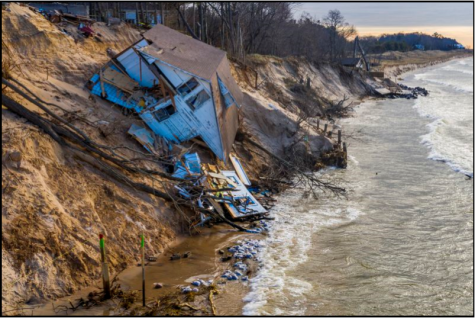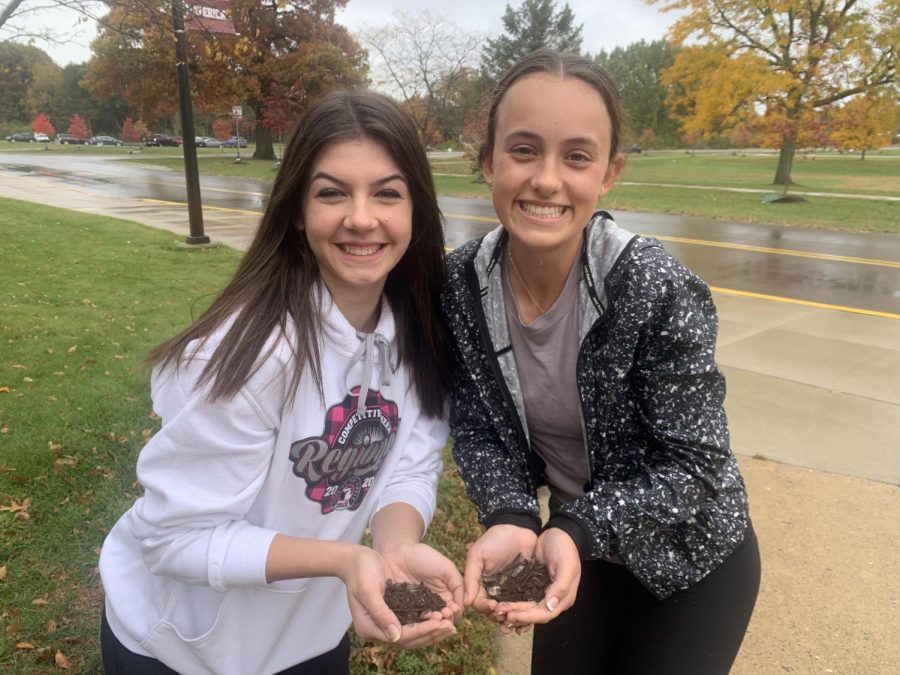The vast environmental issue happening right beneath our feet
Seniors Leah Fitzgerald (left) and Caroline Colt (right) immerse themselves in nature and learn more about soil degradation
April 27, 2023
Five mass extinction events: gigantic glaciers melting, volcanic eruptions, extreme temperature fluxes, methane poisoning and asteroid strikes. These intense natural disasters caused the death of millions of creatures over the course of Earth’s history, but for humankind, the disaster might simply be dirt.
It may sound implausible but soil degradation, the decline of soil quality, is wreaking silent havoc on the environment. Furthermore, there is an immense correlation between many aspects of the resources necessary for human survival and the quality of the Earth’s soil.
A major contributor to soil erosion is substandard farming practices that cause fertilizers to leach into the dirt. With the leaching of these toxic pesticides, also comes the tampering of aquifers, which allow for underground water storage, so when they are polluted by fertilizers from above, the quality of water decreases.
A key component of fertilizers is nitrogen which already leeches easily through soil and into the groundwater held by the aquifer. As the soil erodes, this speeds up the process of nitrates getting into the water.
Milford High School’s Advanced Placement Environmental Science Teacher, Stephanie Crow, offers some insight on another issue posed by soil deterioration. “The biggest issue is the loss of plants. We need plants for food, oxygen-carbon dioxide exchange and water retention.”
The loss of plants also translates into a loss of animals. The decrease of both plants and animals can be defined as an overall loss of biodiversity. According to the Living Plant Report performed by the World Wildlife Fund, “The world has seen an average 68% drop in mammal, bird, fish, reptile, and amphibian populations since 1970.” As soil degradation continues to increase, so will the rate of extinction and endangerment of biotic environmental components.
Every ecosystem maintains a delicate balance that is greatly affected by the rapid or subtle change in a species’ population. If certain populations are thrown off-balance, the entire ecosystem can change by impacting plant growth and increasing invasive species populations that can both be harmful. This damages the water that we drink and the plants that provide us with oxygen.
According to weforum.org, it’s estimated that “40% of land on earth is now degraded.” As this percentage continues to increase, it’s important to find ways to address this issue at the earliest stage possible, which is right now.
Many people may feel out of touch with this issue because it’s hard to imagine the huge impact dirt has on our daily lives. However, soil is responsible for protecting our wa

ter sources, assisting in the growth of our food, and supporting the plants that provide us with oxygen.
Crow offers a way in which this issue impacts Michigan citizens. “The Michigan connection is along the big lake shores. As people want to have homes on the shoreline, they break down and degrade the soil in those areas…The consequence is erosion, loss of water purification ability and loss of habitats for shore dwellers.”
With that in mind, there are simple changes that can be made by everyone for the improvement of this ever-encroaching problem for humankind. Crow adds that a minor change that can take place to help reduce the issue of soil degradation is “to continue to replace plants when building along shorelines.”
Plants are extremely helpful in holding dirt together using their intricate root systems. The foliage of plants can also become a protection layer for the soil. Additionally, the plant root systems slow down the process of leaching, which in turn minimizes the number of nitrates making their way into the groundwater.
Additionally, it’s important to ensure that people plant native plant species rather than invasive plant species. As the National Park Service points out, the “Use of native plants also helps restore native habitat for birds, small mammals, and estuarine invertebrates, which are vital to the success of the coastal marsh ecosystem.”
Overall, the simple solution of planting more native plants along shorelines, would have a major impact on the protection and health of Michigan soil.
However, many Michigan citizens don’t live along shorelines. In this case, working to promote plant growth by simply planting a tree or creating a home garden can help improve soil quality.
In addition, it’s very effective to follow and support policies proposed by the government to increase soil health. For instance, The Network for Public Health Law, points out the Farm Bill which was enacted in 2018 and expires in 2023. As we reach the waning end of this legislation, it’s important for people to encourage policymakers to continue to produce regulations requiring sustainable farming practices and conservation programs.
The Natural History Museum states that the best way to improve soil quality is making sure “Communities, farmers and corporations can be educated about sustainable practices to promote respect and responsibility for nature and reduce their carbon footprint.” Although some environmentally-conscious choices may not directly impact soil quality, they all work to promote plant growth which is one reason soil deterioration is a problem in the first place. With each person putting forth a small effort by encouraging sustainable farming legal actions, creating gardens and reducing their carbon footprint, we can begin to restore the quality of Earth’s soil and avoid adding ‘soil degradation’ to the mass extinction list.
